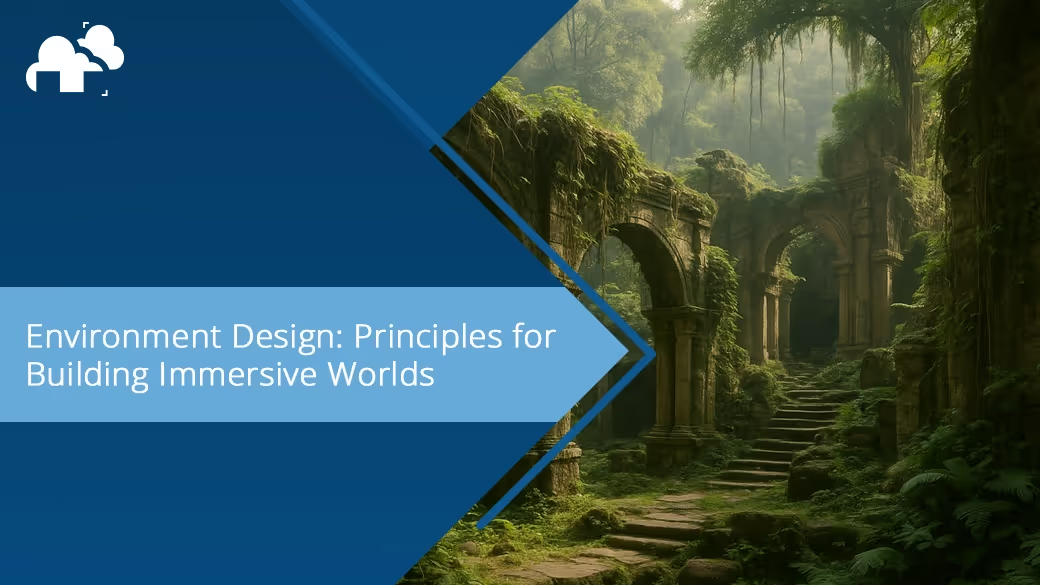
Environment design is more than arranging objects in 3D space, it's the art and science of shaping immersive, believable worlds that inform story, guide behavior, and enhance visual storytelling. Whether you're crafting a bustling urban marketplace or a moody, overgrown ruin, the choices you make from lighting and color, to composition, and prop placement have a profound impact on how your audience perceives and interacts with your environment.
Environment design refers to the process of creating settings that visually and contextually support storytelling across mediums like film, games, animation, and VR. At its core, it is a convergence of concept art, architecture, landscape design, and visual storytelling. Great environmental design enhances immersion, guides user behavior, and shapes mood. It’s not just about filling space, it's about using shape, shadow, and light to construct a world with rules, culture, and history. Some key disciplines that overlap in environmental design include:
Every great environment starts with exploration. The design journey typically unfolds across these stages:
Using fast, rough sketches to explore space, angle, and layout. These help you identify the best composition early and play with story beats. Is this a war-torn village or a tranquil greenhouse? Is it viewed from a bird’s-eye angle or a low, immersive perspective? This stage allows for ideas to be explored and come to life to see what could work and what couldn’t, and how things can be further refined and visualized into the final design.
Collect real-world inspiration: natural formations, architectural patterns, color palettes, materials. Organize references to inform the aesthetic and functionality of your scene, and further solidify the environment you are making through real life examples. Tools like PureRef are perfect for this stage as well, as it allows users to place images and notes without losing the original image’s quality.
Bring your sketches to life using 3D primitives. Focus on scale relationships, negative space, and readability, as well as composition. Ask yourself if viewers can understand the scene at a glance, and if there is a clear visual hierarchy. You can also start with ready assets if available to speed up the process.
At this stage, lighting becomes a storytelling device. Volumetric lighting can bring more life to a scene and the way the lights are placed, the intensity, etc., can all help with drawing visual focus to what you intend for viewers to see and feel. Using gobos (custom textures applied to light sources) can also add visual richness and simulates real-world complexity, like sunlight filtering through trees or window blinds.
Creating a believable world means thinking beyond aesthetics. Good environmental design guides the viewer, reflects context, and creates a sense of history.
Study real-world topography and architectural logic. A desert village near a mountain may rely on shaded pathways and wind-blocking structures. Organic forms can soften layouts, while rigid geometry can suggest industrial order.
Design spaces with purpose: Where do people gather? Where do they rest? What areas feel unsafe? The Broken Windows Theory teaches us that environmental cues influence behavior. A clean, well-lit home office suggests productivity, while cluttered alleys might imply danger or decay.
Environment scale must match user interaction. Small-scale environments (like a factory floor) need dense storytelling details. Large-scale (like a sci-fi canyon) benefit from atmospheric storytelling and silhouette hierarchy.
Let the world reveal narrative: worn steps, overgrown plants, rusted playgrounds, all imply passage of time. Props and layout decisions are micro-stories that enhance macro-worldbuilding.
Visual storytelling hinges on deliberate color, lighting, and composition choices. These elements create mood, focus attention, and establish harmony.
Borrow from cinematography. Use Key, Fill, and Rim lighting to sculpt subjects and suggest time of day or emotional tone.
Colors guide emotional responses. Use warm tones (orange/red) to suggest comfort or danger, cool tones (blue/green) to imply calm or isolation. Blue light in a home office, for example, enhances alertness, while warm tones in social environments foster relaxation. Maintain a cohesive palette. Limit your color families and play with saturation and value to create variation without chaos.
Strong composition guides the viewer’s eye and emotion, often using tools like the Rule of Thirds, which places key elements along a 3x3 grid for balanced visuals. For more dynamic scenes, the Golden Ratio offers natural flow through spiral placement, while Golden Triangles use diagonals to inject energy and tension. Add leading lines like paths or light rays to direct focus, and balance hard shapes (architecture) with organic forms (plants) to create contrast. Use symmetry for order or break it intentionally to suggest chaos, each choice shapes how your world is seen and felt. Feel free to explore various composition techniques as well to get the best and most suitable shot for your project.
Design reusable modular pieces (walls, foliage, furniture). These speed up scene building and enforce stylistic consistency.
In large scenes, uneven texel density breaks immersion. Use density tools to ensure detail feels uniform and believable.
Share early renders to collect feedback. Viewing your work from different angles, literally and metaphorically, reveals weaknesses and hidden strengths.
Create lighting variations (sunset, fog, night) early to stress-test your scene. This informs texture choices and helps establish light-material interactions.
Return to thumbnailing after each major step. Does the silhouette still read? Does the composition still tell the story? This iterative mindset ensures clarity doesn’t get lost in the detail pass.
If you want to dive deeper, browse sites like ArtStation, Behance, and architectural visualization portfolios to study how others manipulate lighting, color, and spatial composition for effect.
Environment design is a vast and rewarding discipline that combines logic and creativity, technical skill and artistic intuition. Whether you’re building for a film, a game, or your own portfolio, the principles remain the same: plan with purpose, iterate freely, and light with storytelling in mind. Design with empathy for your audience and clarity in your storytelling.